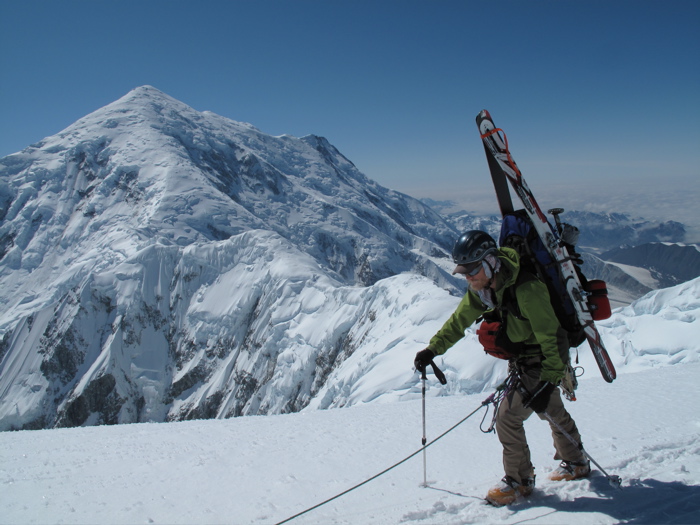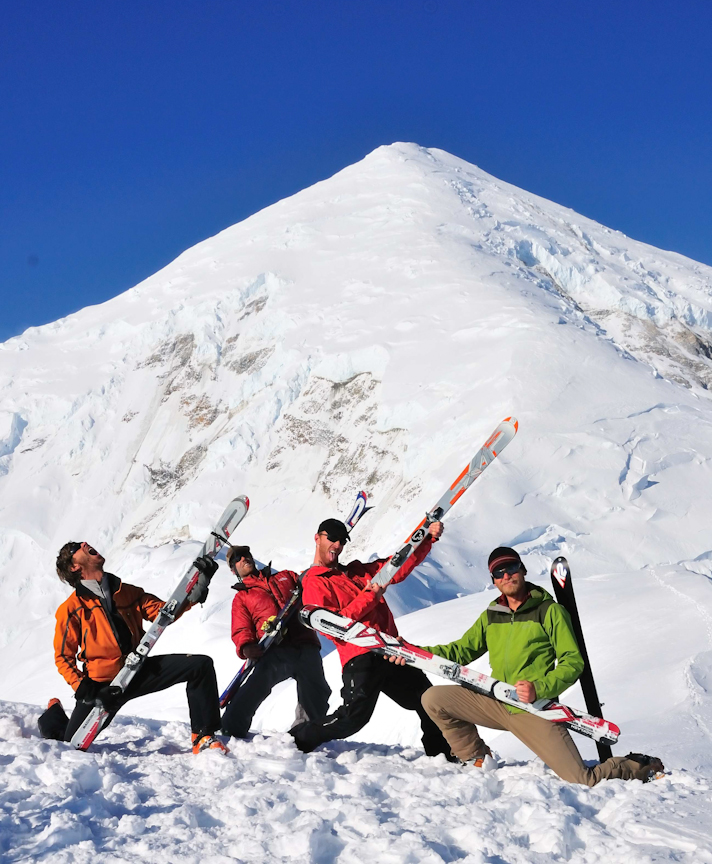Ice Axe's Kip Garre & Andrew McLean Summit Mt. Foraker
Andrew McLean and Kip Garre successfully summited Mt. Foraker (5304 m) in Denali National Park on June 8, 2009. Outstanding job guys! Read Kip’s account of the expedition here.
Mt Foraker
Story by Kip Garre, photos by Fred Marmsater www.silentsummits.comWalking into the Forest Service office in Talketna Alaska the numbers spoke clear, 1105 climbers were registered to climb on Denali in 2009, the highest peak in North America, and only 17 climbers were registered to climb on Mt. Foraker, the second highest peak in the range at 17,400ft. No surprise considering the success rate on Foraker is much lower and that there is no easy route to the summit. So why would someone consider skiing Mt. Foraker? Well because it has snow. And mountains with snow need to be skied.
On May 21st I boarded a plane for Alaska where I would meet Fred Marmsater, Courtney Phillips and Andrew McLean, if all went as planned we would have 19 days to attempt to climb and ski Mt. Foraker. Talketna Alaska is the stepping off town for the Alaska Range and is where we had to convince bush pilot Paul Rodderick to fly us over the Sultana ridge on Foraker so we could see what our proposed route looked like.
Paul was keen on a fly by and an hour and a half later we were standing on the Southeast fork of the Kahiltna glacier starring at Mt. Foraker and the four-mile ridge that connects it to Mt. Crosson. One reason Foraker sees such little traffic is it’s difficult ridge to Crosson that must be crossed to descend. You could easily get stuck on the ridge for days if the pressure dropped and weather got bad.
After loading our gear into the sleds we would haul across the Kahiltna glacier to the base of Mt. Crosson we said good-bye to the park rangers, the last people we would talk to for the next 19 days. Since our base camp would be only two miles from the glacial airstrip where we landed we decided to bring a massive amount of food to keep us fed if the weather decided to give us a proper Alaskan lashing. Bacon, sausage, popcorn, Scrabble and even a handle of Scotch bulged out of sleds.
Arriving at the base of Crosson we were excited to get moving and see how the route would actually climb. After our first night at base, hardly night since the sun barely dipped below the skyline, we woke up and decided to see how far we could make it up the 5,800 ft climb to the top of Crosson. Five hours straight up and we were reminded that the scale here in the Alaska range is hard to comprehend, everything in Alaska in large! Sitting in camp gazing at the turns we had just made on Crosson better helped us decide on an attack plan to ski from the Summit of Foraker. Our route would take us 5,800 ft up Crosson, then descend 2,000 ft to the four mile traverse to reach the base of Foraker where we would have to climb another 5,400 ft to the summit, we thought four days should be enough.
Every night the park rangers give a weather report to let climbers know what the weather is doing, tonight it was a low pressure moving in and that meant we were looking at some tent time. Knowing this we decided to haul food and fuel up Crosson to cash, bury in the snow, we would then return to base and wait ofr the storm.
The next nine days allowed me to catch up on sleep, read and play lots of Scrabble. Each night at eight we would gather around our radio, to listen to the Denali weather with hope that the low pressure was moving out and that a high pressure would give us the weather needed to climb. Patience. Patience. Patience. Mountaineering involves lots of patience and waiting for the proper weather window. Getting stuck on the ridge between Foraker and Crosson has foiled many attempts to climb Foraker, we did not want to spend our time stuck in a tent on the ridge.
After eight days the Denali weather reported that we should get three to four days of good weather. Yes! Finally our waiting was paying off. In the morning we would start up Crosson and head toward Foraker.
Snow from the storm had plastered the slope and made the climbing challenging, deep and slow. But we were headed up and new snow would hopefully help higher on the mountain. Spending the night on Crosson allowed us a good view of Denali and Foraker, the four-mile ridge to Foraker looked to be in good shape and got all of us excited for the climb ahead.
Traversing the ridge between Crosson and Foraker was fun and full contact! It was really broken, the terrain looked liked a puzzle that was not quite put together, full of crevasses, it dropped away for 11,000ft to the West and 6,000 ft to the East. Straight forward but exciting, the kind of challenge that climbers like. About a quarter of a mile from the Sultana ridge, our route on Foraker, we dug a camp into the ridgeline.
We set up camp, hydrated and ate. Five hours later has the sun began its slow descent below horizon we strapped on our crampons and began the climb up the Sultana Ridge aiming for the summit. 5,400ft of crevasse riddled slopes kept all of us focused. With each step we were gaining elevation and loosing oxygen. Although Foraker is only 17,400ft high we all felt the lack of the good energizing oxygen that keeps you moving.
Cresting the plateau and heading for the summit I could tell we were all feeling it! The elevation, long day, new snow and tricky terrain was wearing us down. Seeing the summit allowed me to relax a bit knowing that it was almost time to ski down, I also realized that clouds were moving in and the wind was picking up, we didn’t have much time before the weather would get bad.
Clicking into my skis helped me breathe easier but made me realize what was about to happen. There was a reason no one had skied what we were about to. With the conditions being “good” and the group feeling ready we pushed off with lots of caution.
Skiing down mountains like Foraker is different from skiing at the local resort. Although the motion is the same your concentration and focus are greater. The slope was not to steep but we skied it slower than we would have if we were at Squaw. Each turn counted and falling would have been fatal.
One great component to ski mountaineering is that even at a slow controlled pace you descend quickly. Each turn down allowed me to breathe easier and feel better. The crevasses that presented problems on the way up seem harmless skiing down. The firm snow up high softened down lower and pretty soon the skiing was actually enjoyable. Looking around at the massive relief, thousands of feet down to the glaciers and the size of Denali, 20,320 ft high, was amazing. By now we were being chased off the mountain by winds and clouds.
Approaching the high camp we all wanted to scream in excitement but knew we still had to cross the ridge and ski down Crosson, plus we were all wiped out from twelve hours of climbing. Only when we were back at the airstrip would I relax and revel in the accomplishment. Back at high camp, wasted, the winds really picked up. The storm was on us; the clouds and the winds began to flex muscles, all we wanted was to eat and sleep for a while before we began the climb across the ridge. Instead the next hour was spent securing camp so we wouldn’t blow off the ridge.
When you set out on a climb like this you know that you will go through times of suffering and question, why am I doing this? But you also know that before too long you will be back at base dreaming about the next adventure and laughing about your struggles.
Crossing the ridge and skiing down Crosson went quickly. Up high the skiing was great but deteriorated fast and with three thousand feet to the glacier things got sketchy again. What was snow on the way up had melted out, some ice some dirt. Our camp starred up at us and we begged to be there. Slow and cautiously we crafted each turn perfectly so we would not to fall.
Finally at base camp we finished our scotch and cheered to the mountain that had let us survive. In the morning we would had back to the airstrip and fly to Talketna.

